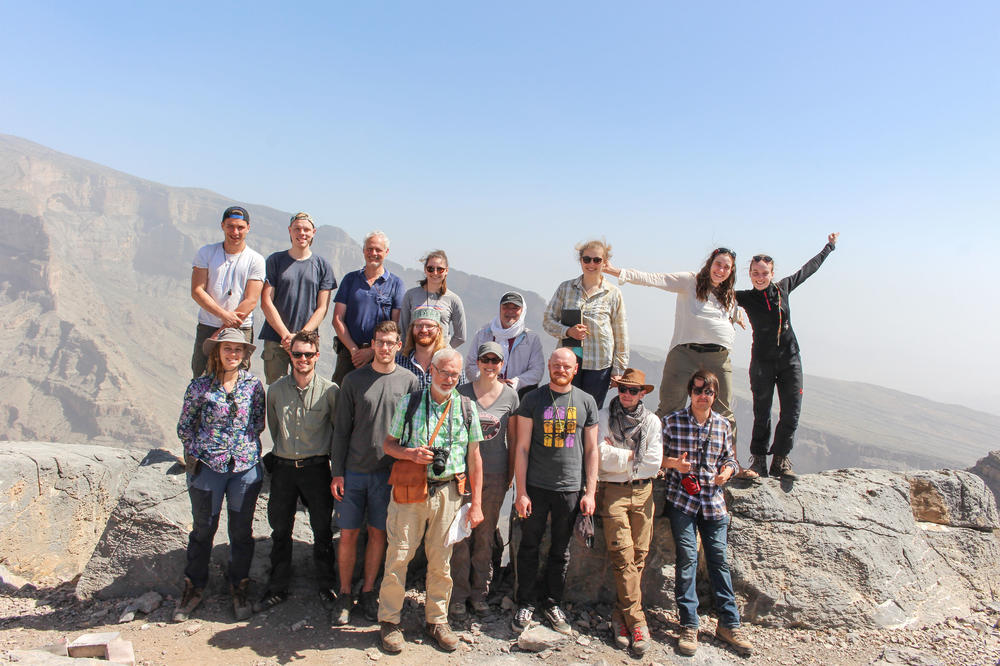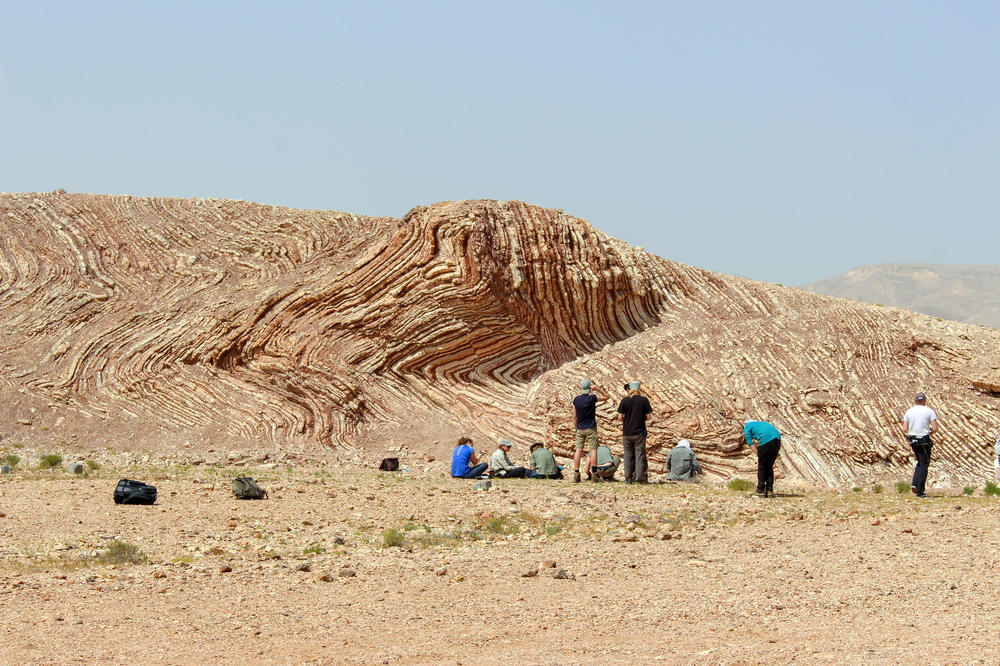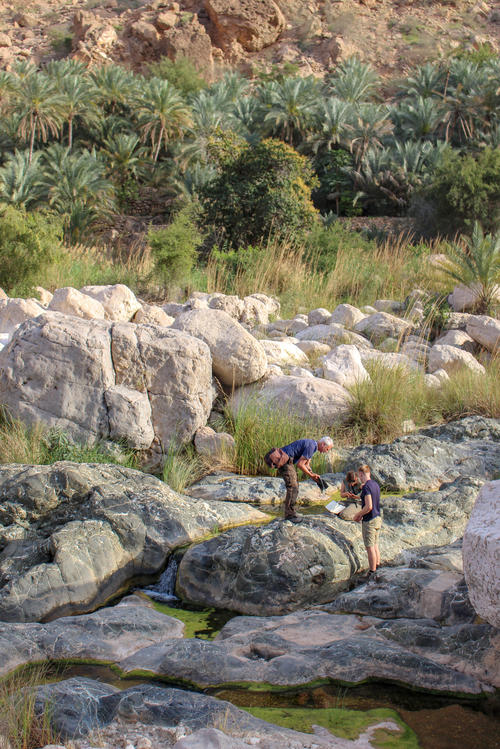Exploring a Treasure Chest
Graduate students from a geology class did research in the Sultanate of Oman in February and March, before travel restrictions due to the coronavirus pandemic were in place.
Jul 07, 2020
The group during a stop at Wadi Ghul. In travel guides, it is called the Grand Canyon of Oman, due to its gorges.
Image Credit: Personal collection
“We were able to see the boundary between the Earth’s crust and mantle,” explains Niklas Kallnik, a geology student in his seventh semester of a bachelor’s degree program. He is still very enthusiastic about the exploration trip to Oman. “This is only possible in one or two other places in the world. As a rule, the transition from crust to mantle lies below the oceanic or continental plate or the Earth’s crust and cannot be reached.” The group consisting of 14 geology students and faculty covered 2300 kilometers in the Sultanate of Oman in just under two weeks.
The aim of the research trip, in pre-coronavirus times, was to examine the components of the oceanic lithosphere – i.e., the Earth’s oceanic crust – and geological processes. “Oman is an absolute hotspot for Earth science investigations,” says Saskia Weitkamp, who is in her third semester of a master’s degree program in geology. She explains, “There, part of the oceanic lithosphere is on the surface of the Earth. That is extremely rare because the oceanic crust, which is denser than the continental crust, normally slides under the continental crust.”
Research and Work in the Field
Investigating the oceanic lithosphere is therefore only possible if you drill deep into the Earth – or travel, for example, to Oman. Situated in the southeastern part of the Arabian Peninsula, in Oman tectonic processes have led to obduction. This term is used to refer to the processes in which the oceanic crust slides over the continental crust. The rock transported to the surface in this way is called ophiolite.
The shift took place about 87 to 76 million years ago, “more than ten million years before dinosaurs went extinct,” says Saskia Weitkamp. However, Earth scientists refer to it as a “relatively young” process.
Due to the dry climate in Oman, it is possible to see rock formations such as the “mother of all outcrops.”
Image Credit: Saskia Weitkamp
So-called outcrops provide a view into the interior of the Earth. At these points, the otherwise hidden oceanic rock is visible on the Earth’s surface. There, the students made observations and collected data on rock structures and mineralogy, among other things. “The aim of the field trip was to apply geoscientific working methods directly to the ophiolite in Oman,” says bachelor student Niklas. In total, the students saw more than 30 outcrops and learned about how diverse the work in the field is.
Perfect Rock Formations at the “Mother of All Outcrops”
One focus of the research trip was on mineralogy. “If you study the properties and the formation of minerals, you can reconstruct the pressure and temperature conditions under which a rock was created,” explains Robert Neumeister, a student in the third semester of his master’s degree program.
For example, the mineral lawsonite, which the group found in eclogites, a type of rock, on the beach at As Sifah: “Lawsonite is formed at relatively low temperatures, below 500 degrees Celsius, but at a high pressure of around two gigapascals. The lawsonite in the rock was formed when the rock was exposed to these environmental conditions in the interior of the Earth, specifically in the subduction zone.”
From left to right: Graduate students Robert Neumeister, Saskia Weitkamp, and Niklas Kallnik
Image Credit: Anne Stiller
Remnants such as rock formations can help to understand tectonic processes. The “mother of all outcrops” was particularly impressive. This is how geologists describe a spectacular outcrop in which the folds in the radiolarite sedimentary rock can be seen very well. “The forces that acted on the rock and caused it to fold can be traced,” says Saskia Weitkamp.
This is possible due to the dry, warm climate in the region. “There is hardly any vegetation. The outcrops have not been overgrown or weathered by meteoric waters such as rain,” explains Robert Neumeister.
Oman is a treasure chest for Earth scientists, albeit a barren one. The students said the environment felt so different, “It felt like we were walking through a lunar landscape.”
River beds, so-called wadis, such as the Wadi Tiwi, provide a change from the predominantly barren vegetation.
Image Credit: Saskia Weitkamp
Reduce CO2 in the Atmosphere by Storing It in Rock?
On their field trip, the group also studied the interactions between carbon dioxide in water and rock. “We saw that under certain conditions an extremely large amount of CO2 can be stored in certain rocks,” says Saskia Weitkamp. An interesting question is how and whether this process could be used industrially.
The storage of carbon dioxide in deep rock layers, so-called CO2 sequestration, is also important in other respects. “All the current climate models that limit global warming by a maximum of two degrees Celsius include CO2 storage as an option, to reduce the carbon dioxide content in the atmosphere,” explains Niklas Kallnik. However, practical implementation of carbon dioxide storage is still in the development stage.
Working in the field enabled the students to study sequestration under natural conditions and not just in a controllable laboratory environment. “It makes a difference whether you study the effects of rock that has been in storage for five minutes or that that has been trapped for millions of years,” says Robert Neumeister.
Walking on the Boundary between the Earth’s Crust and Mantle
Having a chance to look into the interior of the Earth and the outcrops that make tectonic processes visible both surprised and fascinated the Earth science students. But they also had opportunities to get to know other parts of Oman.
“Of course, we were also in the capital Muscat and in the oasis town Nizwa, as well as on the beach and in the desert,” says Saskia Weitkamp. She was able to get a glimpse of the way of life of the Omanis, which she sees as “very different, more relaxed” than the way of life of the Germans. All three of the students can imagine returning to the Sultanate of Oman, whether for study and research purposes, or because of the culture and nature.
The original German version of this article was published on June 30, 2020, in campus.leben, the online magazine of Freie Universität Berlin




